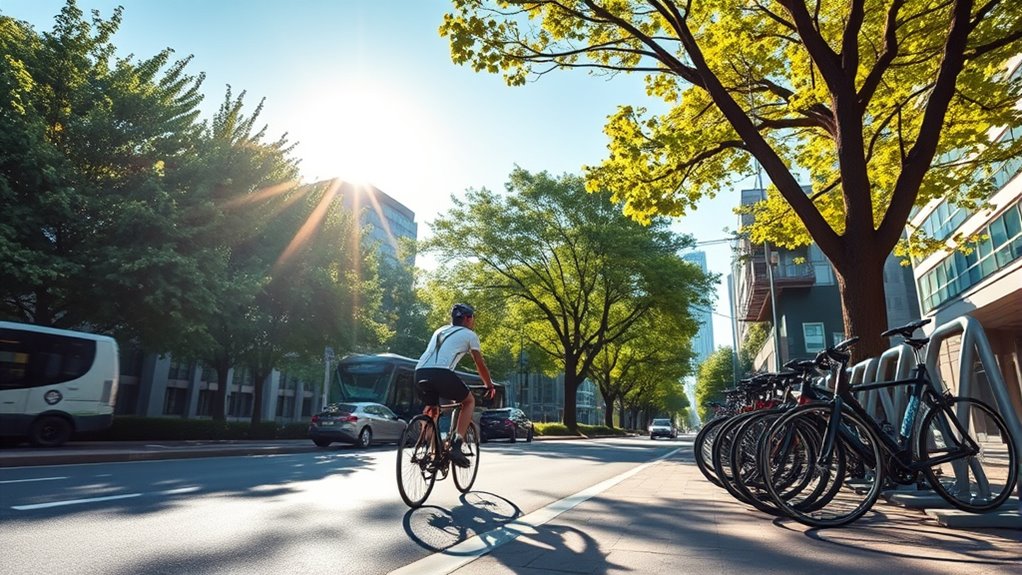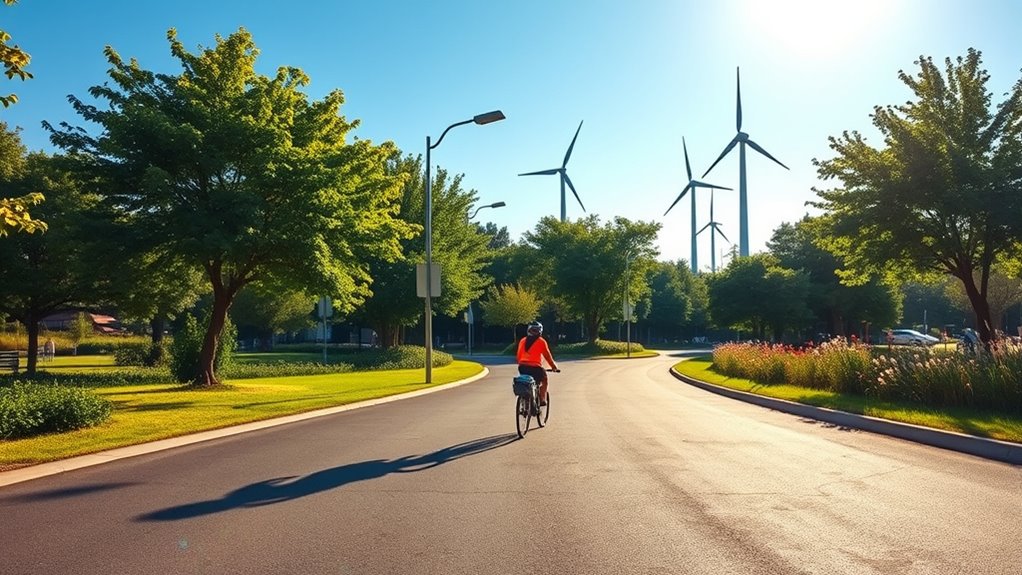Cycling considerably reduces your environmental impact by emitting no greenhouse gases, helping cut urban pollution and your carbon footprint. It also lessens noise pollution and air contaminants in cities, leading to healthier communities. By choosing bikes over motor vehicles, you support sustainable transportation and climate change efforts. Bicycles require minimal resources and produce virtually no emissions during manufacture and use. Keep exploring to discover how your active choices can contribute to a greener, cleaner planet.
Key Takeaways
- Cycling produces no greenhouse gases during operation, significantly reducing urban carbon footprints and supporting climate change mitigation.
- Investment in bike infrastructure and urban planning promotes sustainable transportation and decreases reliance on fossil fuel vehicles.
- Cycling reduces noise pollution and improves air quality, contributing to healthier and quieter urban environments.
- Promoting cycling encourages active lifestyles, enhancing public health while decreasing vehicle emissions.
- Collective efforts in policies and community engagement foster eco-friendly cities and a sustainable future.
Reducing Carbon Emissions Through Cycling

Cycling is an effective way to cut down on carbon emissions because it produces no greenhouse gases during operation. When you choose to bike instead of drive, you reduce your carbon footprint considerably. Proper infrastructure supports safe and accessible cycling, encouraging more people to ride. Supporting bike infrastructure, like dedicated bike lanes and secure parking, makes cycling safer and more accessible, encouraging more people to ride. Improved cycling safety measures help prevent accidents, boosting confidence among riders and promoting regular cycling habits. As cities develop better infrastructure, more individuals will see cycling as a viable, eco-friendly transportation option. This shift decreases reliance on fossil fuel-powered vehicles, leading to lower emissions overall. Additionally, increasing awareness and local resources can further promote cycling as a sustainable transportation choice, and integrating sound health benefits can motivate more communities to adopt cycling as a daily habit. Moreover, investing in advanced technology for bikes and safety gear can enhance rider experience and further support widespread adoption.
Decreasing Noise and Air Pollution in Urban Areas

By shifting to cycling as a primary mode of transportation, you not only reduce carbon emissions but also markedly decrease noise and air pollution in urban areas. Cycling emits less noise pollution compared to motor vehicles, helping to improve the urban soundscape. Fewer vehicles on the road mean less engine noise, honking, and traffic congestion, creating a quieter environment. Additionally, reduced vehicle emissions lower air pollution levels, benefiting public health and the environment. To visualize this impact:
| Before Cycling Adoption | After Cycling Adoption |
|---|---|
| High noise pollution | Significantly lower noise levels |
| Poor air quality | Improved air quality |
| Noisy urban soundscape | Quiet, more peaceful environment |
This shift fosters cleaner air and a calmer, healthier city atmosphere. Furthermore, promoting sustainable transportation like cycling can contribute to long-term environmental benefits beyond immediate noise and air quality improvements. Engaging in active commuting also encourages healthier lifestyles and reduces dependence on fossil fuels, which can help mitigate the effects of climate change and further promote environmental sustainability. Additionally, adopting cycling infrastructure can promote urban greenery, further enhancing the ecological balance in cities. Implementing such measures can also lead to a more livable urban environment, making cities more attractive places to live and work.
Promoting Sustainable Transportation in Communities

Promoting sustainable transportation in communities is essential for creating healthier, more livable urban environments. You can support this by advocating for strong bike infrastructure, such as dedicated lanes and secure bike parking, which makes cycling safer and more accessible.
When communities invest in these facilities, they encourage residents to choose bikes over cars, reducing pollution and traffic congestion. Community engagement is also crucial; by involving residents in planning and decision-making, you foster a sense of ownership and enthusiasm for sustainable transit options. Additionally, highlighting the safety features of cycling infrastructure can further incentivize more people to ride bikes regularly. Incorporating visual and auditory cues in educational campaigns can enhance understanding and promote safer cycling habits. Developing culturally intelligent outreach strategies can also help tailor messages to diverse community groups, increasing participation and acceptance.
Educational campaigns and local events can further promote cycling as a practical, eco-friendly choice. Moreover, incorporating proper lighting and signage enhances visibility and safety for cyclists and pedestrians alike. Additionally, aligning infrastructure development with large-scale event logistics can maximize safety and efficiency for all attendees. Together, these efforts help build a culture that values sustainable transportation, leading to cleaner air, quieter streets, and more vibrant neighborhoods.
Comparing the Environmental Footprint of Bicycles and Motor Vehicles

Investing in bike infrastructure not only encourages more people to choose bicycles but also highlights the significant environmental benefits compared to motor vehicles. Bicycles produce minimal resource consumption, requiring no fuel and less manufacturing impact, which helps in ecosystem preservation. High-quality equipment for bicycles can further reduce environmental impact by increasing durability and lifespan. Using sustainable materials in manufacturing can also contribute to a lower environmental footprint. Moreover, utilizing vetted electric bike conversion kits can enhance cycling’s practicality and sustainability by providing efficient motor assistance without significantly increasing resource use. Incorporating dynamic communication exercises into cycling communities can foster greater engagement and support for sustainable transportation initiatives. Motor vehicles, on the other hand, emit greenhouse gases, consume large amounts of fossil fuels, and contribute to pollution and habitat disruption. Here’s a comparison:
| Aspect | Bicycles | Motor Vehicles |
|---|---|---|
| Resource Consumption | Very low, mainly metal and rubber | High, fuel and extensive materials |
| Emissions | Virtually none | Significant CO2 and pollutants |
| Ecosystem Impact | Minimal, local impact only | Heavy, habitat and air quality degradation |
| Manufacturing Footprint | Low | High |
| Maintenance | Minimal | Frequent, resource-intensive |
Choosing bicycles promotes a greener future with less resource depletion and stronger ecosystem preservation. Additionally, sustainable transportation plays a crucial role in reducing overall environmental impact and combating climate change.
How Cycling Supports Climate Change Mitigation Efforts

Cycling plays a crucial role in fighting climate change by considerably reducing greenhouse gas emissions. When you choose to bike instead of drive, you cut down on fossil fuel consumption and air pollution. Wall organization systems can also contribute to creating safer and more inviting cycling environments when integrated into urban planning. Supporting bike infrastructure makes cycling safer and more accessible, encouraging more people to ride. As cycling advocacy grows, policymakers are more likely to invest in dedicated lanes and bike-friendly cities, amplifying these benefits. Your participation in cycling initiatives can influence local governments to prioritize sustainable transportation. By promoting cycling as a practical, eco-friendly option, you help shift societal norms toward low-carbon mobility. Every ride contributes to climate change mitigation efforts by decreasing reliance on motor vehicles and fostering sustainable urban development. Implementing bike-friendly infrastructure is essential for long-term success in reducing transportation emissions. Together, these actions create a greener, healthier planet for future generations.
Frequently Asked Questions
How Does Cycling Impact Local Biodiversity and Ecosystems?
Cycling can positively impact local biodiversity and ecosystems by reducing pollution and habitat disruption caused by motor vehicles. When you choose to bike, urban wildlife benefits from cleaner air and less noise, helping preserve habitats.
Additionally, cycling infrastructure can promote habitat preservation by encouraging eco-friendly development. By cycling, you support healthier ecosystems and create space for urban wildlife to thrive, fostering a balanced environment for both people and nature.
What Are the Challenges of Integrating Cycling Infrastructure Globally?
Think of integrating cycling infrastructure worldwide as trying to weave a universal tapestry. You face challenges like adapting urban planning to diverse city layouts and overcoming cultural barriers that may resist change.
Every region has its traditions and priorities, making uniform solutions tough. You need to foster collaboration, respect local customs, and design flexible, inclusive plans so that cycling can truly become a global movement.
How Do Cycling Habits Influence Urban Heat Island Effects?
Your cycling habits can considerably influence urban heat island effects by promoting urban cooling.
When more people bike instead of drive, it reduces carbon emissions, acting as a carbon offset that mitigates global warming.
Cycling also encourages the creation of green spaces and reflective surfaces, which help dissipate heat.
Can Cycling Reduce Healthcare-Related Environmental Costs?
You can cut healthcare-related environmental costs by choosing cycling over driving, reducing emissions, and promoting physical activity. With each pedal stroke, you save on medical expenses, lower pollution levels, and decrease energy use.
These benefits lead to significant cost savings for communities and individuals alike, while also contributing to emission reductions that protect our planet. Embracing cycling isn’t just healthy—it’s a smart move for our environment and economy.
What Policies Best Encourage Eco-Friendly Cycling Practices?
To encourage eco-friendly cycling practices, you should support policies that promote bike sharing programs and enforce cycling safety regulations. These initiatives make cycling more accessible and safe, motivating more people to choose bikes over cars.
When local governments invest in bike lanes and safety measures, you’ll find it easier to cycle confidently and sustainably. Such policies help reduce pollution and foster a greener environment, benefiting everyone.
Conclusion
By choosing cycling, you become part of the solution, helping to clear urban skies and quiet streets. Imagine a city where the air is fresh, noise is minimal, and green spaces flourish—all thanks to your pedal power. Cycling isn’t just a mode of transport; it’s a movement toward a healthier planet. As you pedal forward, picture yourself driving change—one ride at a time—toward a greener, cleaner future that benefits everyone.









